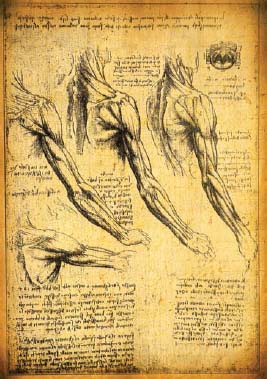The Early Modern World, C. 1300–1600High Renaissance in Italy |
Who was Leonardo da Vinci? |
Leonardo da Vinci (1452–1519) is one of the most famous artists of all time. He was the illegitimate son of a Tuscan notary and went on to train in the workshop of master artist Andrea del Verocchio in Florence. Leonardo da Vinci was a genius, and well known during his lifetime for his intellect and peculiarity. He was fascinated with the visible world, and spent hours drawing what he saw. It was as if for da Vinci, drawing was a method of understanding. Thousands of da Vinci’s sketches have survived—drawings of human faces, swirling water, birds in flight, dissected corpses, the human skeleton, nature scenes, toy designs, and more. He wrote extensively on theories of art and science, creating categories of facial types, explaining techniques of atmospheric perspective, and analyzing the movements of the sun. Da Vinci was hired by Italian governments to design weapons and war machines, including the so-called “siege-machine.” Designs for these weapons appear in sketch-form in his notebooks. Despite his prolific writing and drawing, da Vinci never published any of this work and wrote all of his notes in reverse—rendering his notes readable only when held up to a mirror. It is possible he was paranoid of being declared a heretic by the church, or that he was simply intensely private.
It is clear that Leonardo da Vinci was not merely a painter, but a true “Renaissance Man.” His paintings are among the most famous works of art in the world and include The Last Supper fresco in Milan and the Mona Lisa. Many of da Vinci’s works have deteriorated significantly over time.

Leonardo da Vinci used drawing as a means of understanding the world around him. The arist’s private sketchbooks are filled with drawings of the natural world and scientific phenomena, including anatomical sketches, drawings of the womb, and the illumination of the moon.
